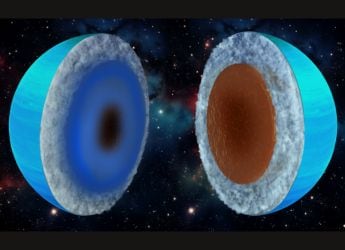- Home
- Science
- Science News
- Is It Really Possible to Terraform Mars? ‘Doable’, Says NASA’s Top Retiring Scientist
Is It Really Possible to Terraform Mars? ‘Doable’, Says NASA’s Top Retiring Scientist
Green, who had been involved in key roles in several missions and experiments, retired from NASA at the beginning of this year.

Photo Credit: NASA
NASA's Jim Green says Mars was once a blue planet (contained water) and so was Venus
Finding signs of alien lives on other planets has been one of the significant preoccupations of explorers and scientists. Yet, not much has been achieved so far. But scientists are not giving up their quest and appear determined to unravel the mysteries surrounding our solar system. Promisingly trying to answer the most puzzling questions of all: whether we are alone in this world and are there or have been more extra-terrestrial species? Whether other planets are or were capable of supporting lives? In a recent interview, Jim Green spoke about his CoLD scale and explained how we can terraform Mars to make it habitable for humans.
Green joined NASA in 1980 and since then he has been involved in key roles in several missions and experiments by the space agency. He has helped NASA undertake various complex missions, including understanding Earth's magnetic field and searching for life on Mars. After spending four decades at NASA, during 12 of which he headed its planetary science division, Green retired from the agency on the new year. “Confidence of life detection,” or CoLD, scale is one of his remarkable proposals. Green has proposed that humans could one day live on Mars if we create a giant magnetic field on the Red Planet to stop the Sun from stripping the atmosphere there, raising the temperature on the Martian surface.
Mars is harsh and cold as its thin atmosphere is 95 percent carbon dioxide. The temperature on the barren planet is about minus 60 degrees Celsius, on average. During winters, the temperature near the poles can dip to minus 125 degrees Celcius.
Against this backdrop, how good does Green's scale work? Asked about it during an interview by the New York Times, Green said the possibility of the existence of life is measured on his CoLD scale from one to seven, where seven means life. Explaining its importance, he said a couple of years ago some scientists said they'd found phosphine on Venus. For them, it was enormous but on the CoLD scale it was “one”. Later, they realised there was contamination in their signal, and what had found many not even be phosphine.
On Mars, a lot of methane has been detected. “(But) we're only at a CoLD Level 3.”
Despite NASA running Mars exploration since 1976, is he surprised that we haven't found life on the Red Planet yet? “Yes and No," Green said. He said scientists have made great advances since the early days. For instance, we know now that Venus was once a blue planet with a significant ocean. “It might actually have had life,” he added. Similarly, Mars too was a blue planet once.
Speaking about his proposal to create a giant magnetic shield between Mars and the Sun, allowing the Red Planet to trap more heat and become warmer, he said, “It's doable”. Mars is going to terraform itself with the increase in pressure and temperature, he added. The higher temperature and pressure will enable us to begin the process of growing plants in the soils.
He said is trying to get “a paper out” that he has been working on for two years. However, he added, it's not going to be received well by the planetary community, which “does not like the idea of terraforming”. But Green said he is confident that we can change Venus, too, with a physical shield.
Get your daily dose of tech news, reviews, and insights, in under 80 characters on Gadgets 360 Turbo. Connect with fellow tech lovers on our Forum. Follow us on X, Facebook, WhatsApp, Threads and Google News for instant updates. Catch all the action on our YouTube channel.
- Samsung Galaxy Unpacked 2025
- ChatGPT
- Redmi Note 14 Pro+
- iPhone 16
- Apple Vision Pro
- Oneplus 12
- OnePlus Nord CE 3 Lite 5G
- iPhone 13
- Xiaomi 14 Pro
- Oppo Find N3
- Tecno Spark Go (2023)
- Realme V30
- Best Phones Under 25000
- Samsung Galaxy S24 Series
- Cryptocurrency
- iQoo 12
- Samsung Galaxy S24 Ultra
- Giottus
- Samsung Galaxy Z Flip 5
- Apple 'Scary Fast'
- Housefull 5
- GoPro Hero 12 Black Review
- Invincible Season 2
- JioGlass
- HD Ready TV
- Laptop Under 50000
- Smartwatch Under 10000
- Latest Mobile Phones
- Compare Phones
- Redmi Note 15 5G
- Redmi Note 15 Pro 5G
- Redmi Note 15 Pro+ 5G
- Lava Play Max
- Poco C85 5G
- Honor Magic 8 Lite
- Jolla Phone
- Realme P4x 5G
- Asus ProArt P16
- MacBook Pro 14-inch (M5, 2025)
- OnePlus Pad Go 2
- Poco Pad M1
- Just Corseca Skywatch Pro
- Honor Watch X5
- Acerpure Nitro Z Series 100-inch QLED TV
- Samsung 43 Inch LED Ultra HD (4K) Smart TV (UA43UE81AFULXL)
- Asus ROG Ally
- Nintendo Switch Lite
- Haier 1.6 Ton 5 Star Inverter Split AC (HSU19G-MZAID5BN-INV)
- Haier 1.6 Ton 5 Star Inverter Split AC (HSU19G-MZAIM5BN-INV)












